Vacuum valve for sewage: principle of operation + installation of a fan valve
The unpleasant smell coming from the sewer is a fairly common occurrence in our homes and apartments. Therefore, it is important to know that there is an easy way to improve its performance without resorting to major repairs.
A vacuum valve for sewage (or as it is also called an air valve, aerator, ventilation duct, fan valve) allows you to improve the system, and in some cases even abandon the construction of a fan ventilation riser.
In our material we will talk about the device and the purpose of the aerator, as well as how to independently install it in the sewer system.
The content of the article:
Signs of a sewage problem
Violations in the operation of the sewage system can be identified by characteristic signs.
These are:
- the presence of extraneous sounds;
- the spread of unpleasant odors.
In houses with a long-established sewer network, it is first necessary to check for damage to all elements of the network. Deviations in the operation of the new system may indicate incorrect installation.
If during the inspection it was possible to exclude such causes of possible damage as cracks in the pipelines, sewage blockages or ventilation ducts, incorrect pipe slope, then the cause of the problems is most likely due to insufficient air flow. In this case, installation of a vacuum valve will help to solve the system problems.
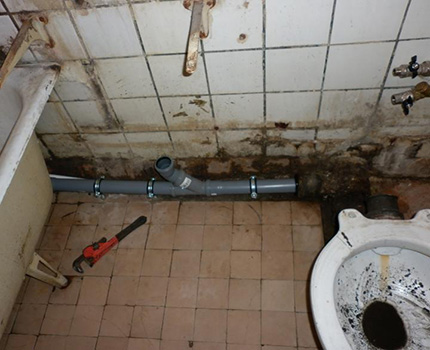
Principle of operation and purpose of the vacuum valve
During maximum drainage hours and during the discharge of large quantities of water, air rarefaction and water from siphon water trap It is absorbed, and odors, harmful gases and vapors enter the room.
A vacuum valve is installed to compensate for the pressure in the sewage system. It prevents the absorption of water and the smell from siphons.
It happens as follows. The vacuum valve starts to work during a pressure drop in the sewer network. At the time of discharge of a large volume of wastewater (for example, when using a toilet bowl or several plumbing fixtures), the system liquefies and the valve membrane automatically opens, letting air into the pipeline until the pressure is equalized.
If the sewage system is not used, the valve remains closed and prevents the entry of vapors and gases into the room.
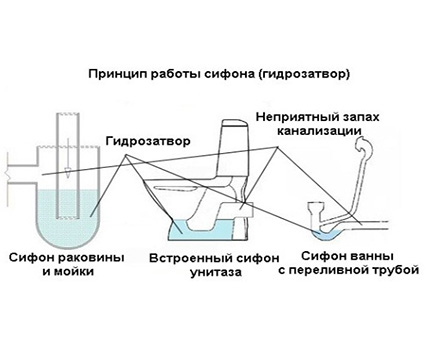
Main scopes:
- Unventilated sewer networks. In systems in which it is not possible to connect the exhaust part to the pipeline, an air valve is allowed. A device is used for aeration of toilets, sinks, where the consumption of a large number of drains can lead to the creation of an imbalance of pressure and the drawing of water out of the water seal.
- Long horizontal sewer networks with a large number of plumbing points and a high probability of volley discharge. For example, in public toilets. In such places, in order to prevent breakdown of the water lock, an aerator is installed every three plumbing points.
- Systems in which plumbing is located far from the riser, and the product sewer pipe slope (expressed in mm / m) exceeds the hydraulic shutter height.
A vacuum valve (aerator) allows you to save materials and money during the construction of utility networks in low-rise buildings, refusing to install a ventilation pipe.
In multi-storey buildings, it can only be used as additional equipment used to optimize the operation of the sewage system.
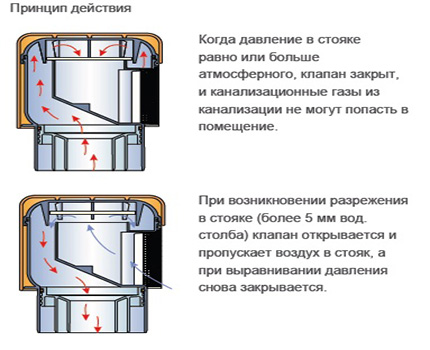
Pros and Cons of Using a Vent Valve
To ensure that gases, vapors and odors from the piping system do not enter the house, provide ventilation, which will facilitate their removal from the system.
The principle of ventilation is based on the inflow of air from the vent pipe of the septic tank, the passage of air flows through the external and internal sewer networks and their exit through the ventilation duct brought to the roof.
So, the air passing through the septic tank and the sewage system carries away all the smells, leaves with them through the ventilation riser in the roof and then dissipates. In the absence of a ventilation system, unpleasant odors and volatile substances from the septic tank and pipes can enter the room through torn hydraulic valves.
The presence of a ventilation system in the building ensures that odors do not penetrate into the premises even when the siphons are broken or dried up. But sometimes arranging a fun channel is impossible or causes great difficulties.
This may occur due to the characteristics of the roofing material, due to the roof being used, the impossibility of the exhaust riser outlet being located far from balconies, windows, ventilation systems. In this case, the exhaust part is led out to the attic, and an aerator is mounted on its top.

A vacuum valve cannot be a complete replacement for ventilation risers, but its use can be justified by the following advantages:
- easy and quick installation;
- money saving;
- the inability to install a fan riser;
- minimization of heat loss through ventilation risers;
- improvement of the sewer network and greater freedom in its planning.
Simply put, the ventilation valve solves only one problem - it prevents the breakdown of the fan valve, while the fan riser equalizes the pressure in the network, and also ventilates the septic tank and the internal sewage system.
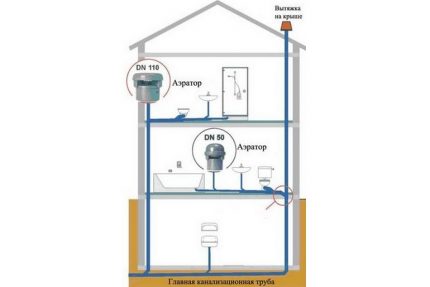
When installing a non-ventilated system or replacing a ventilation riser with an aerator, it is necessary to correctly calculate the throughput of the network in order to exclude the possible failure of siphons or failure of fan valves.
It should also be taken into account that if the building is not inhabited all year round, it may happen that the hydraulic gates will not be filled with water (dry) and air from the sewage system will enter the premises, which will not happen with the installation of a ventilated riser.
Design and operating conditions of the device
The body of the fan valve for arranging the sewage system is made of propylene. The internal mechanism can be equipped with a rubber membrane or stem, which allow air to pass into the system without releasing it back to the premises. The stem valve is considered more reliable, since its working part wears out more slowly.
When choosing a valve, pay attention to the following characteristics:
- for open or closed installation;
- required diameter of the connecting outlet;
- with an ordinary or double heat-insulating wall of the riser;
- what locking mechanism is used - membrane or rod;
- for vertical or horizontal (with a T-shaped connection) connection.
Strict requirements are set for vacuum valves for sewerage, each of them is tested for tightness and reliability - during operation they can withstand more than 800 thousand operation cycles without loss of performance.
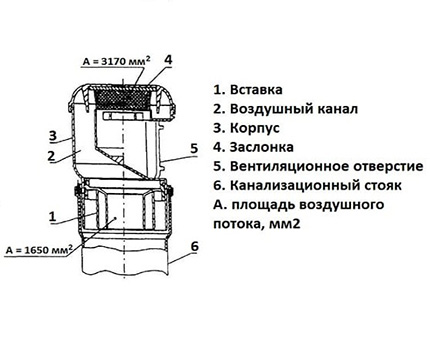
General rules for installing the fan valve
Before installation, the valve must first be checked for leaks. The easiest way to do this is to fill it with water from the side on which air should not enter the inside of the housing and check this part for leaks.
The aerator is installed exclusively in an upright position. When placed horizontally or tilted, the manufacturer does not guarantee its correct operation. To achieve the desired location when installing the valve, you can use tees and elbows to help install it vertically.
Although the device does not require regular technical inspection, you still need to provide access to it for cleaning if necessary.
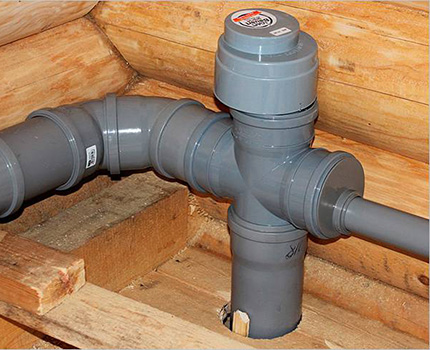
During installation, it is necessary to ensure the free flow of air to the aerator, since water during draining is able to entrain air, the volume of which is 25 times the amount of wastewater itself.
It is especially important to consider this feature when flush mounting an aerator for a sewer system.

It is installed above the connection level of the extreme discharge point (in the place farthest from the riser). To exclude the possibility of contact with the sealing membrane - the main working element - spray and dirt, the aerator is installed above 300 mm from the junction with the riser.

The device is mounted in places accessible for air intake. It can be an attic, a technical floor or a bathroom in the upper floor of the house. All rooms should be ventilated or equipped with hoods.
The operating temperature range of different device models can range from –50 ° C to +95 ° C. When installing the aerator in the unheated part of the house, the sewer riser (pipe) is insulated. The valve body can not be protected from negative temperatures, since there is an air cavity between its cover and the body, which can serve as a heater.
Step-by-step installation instructions
Most air valves are manufactured by manufacturers for connection to DN110 pipes. If the connecting size of the device does not match the size of the pipe, a special adapter is used. For DN50 or DN75 pipes, aerators with the appropriate diameter of the connecting outlet or equipped with a reducing insert are used.
It must be remembered that a valve designed for pipes with a diameter of less than 110 mm can be installed for a maximum of two plumbing points.
Reducing inserts, various adapters are used in the areas of transition from a pipe of a larger diameter to a valve with a smaller diameter. To install the aerator on cast iron pipe there are also special adapters that provide a reliable joint plastic with metal.
Initially, the work determines the place of installation of the valve, taking into account the rules of installation and its availability for further maintenance.
Next, perform the following steps:
- Turn off the water supply in the house.
- If the installation is carried out on a previously installed pipeline, then insert and install a special adapter.
Most models of aerators have a bell type connection.
The assembly of such compounds is carried out in the following sequence:
- The outer surface of the smooth part and the surface inside the bell are dust free.
- Wipe the sealing ring from possible contaminants and put it in the chute of the socket.
- Surfaces that touch during jointing are lubricated to reduce friction. To do this, use a sealant made on a silicone basis or a soap solution, glycerin.
- Insert the smooth end of the valve into the socket to the mark. The quality of the connection is checked by turning the parts relative to each other, with the subsequent return to its original position.
If necessary, a section with a connected vacuum valve is secured with a clamp. At the end of the work, it is necessary to check the joints for leaks.
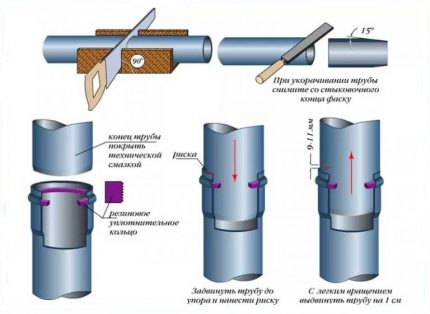
For flush mounting use special models of vacuum valves. If the riser is hidden in a stub or a protective box, then measures must be taken to ensure that air enters the fan sewer valve. To do this, by the size of the aerator mesh, make a vent.
The aerator body is buried in the wall, the fastening element is adjusted so that its outer edge is flush with the wall surface. The only element that remains visible is the decorative grille, which can be fastened with self-tapping screws or inserted manually. For aesthetic reasons, it is available in the most popular color options - white, gray, black and chrome.
Some valve models can be used as openings for sewer cleaning. To do this, remove the decorative cover, take out the internal mechanism of the fan valve and inside a cable.
Conclusions and useful video on the topic
The principle of operation and purpose of the fan valve:
Installing a fan valve, of course, can significantly improve the operation of the sewer network. But you should not consider its installation as a panacea for all possible troubles associated with poor performance of the drain system.
If you yourself installed the air valve in the sewage system or have the necessary knowledge and skills, please share them with our readers. Leave your suggestions, ask questions in the block below.

 Do-it-yourself replacement of sewage in the apartment: detailed instructions for replacing the riser and pipes
Do-it-yourself replacement of sewage in the apartment: detailed instructions for replacing the riser and pipes 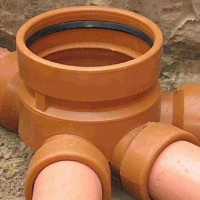 Sewer pipes PVC and HDPE for outdoor sewage: types, characteristics, advantages and disadvantages
Sewer pipes PVC and HDPE for outdoor sewage: types, characteristics, advantages and disadvantages  Manhole for sewage: installation of a well in storm and sewage systems
Manhole for sewage: installation of a well in storm and sewage systems  Pipes for domestic sewage in the house: a comparative overview of modern types of pipes
Pipes for domestic sewage in the house: a comparative overview of modern types of pipes  Insulation for sewer pipes: types, selection rules and overview of laying technology
Insulation for sewer pipes: types, selection rules and overview of laying technology 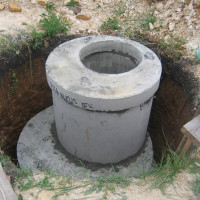 How to make a sewer well: do-it-yourself installation and installation
How to make a sewer well: do-it-yourself installation and installation  How much does it cost to connect gas to a private house: the price of organizing gas supply
How much does it cost to connect gas to a private house: the price of organizing gas supply  The best washing machines with dryer: model rating and customer tips
The best washing machines with dryer: model rating and customer tips  What is the color temperature of light and the nuances of choosing the temperature of the lamps to suit your needs
What is the color temperature of light and the nuances of choosing the temperature of the lamps to suit your needs  Replacement of a geyser in an apartment: replacement paperwork + basic norms and requirements
Replacement of a geyser in an apartment: replacement paperwork + basic norms and requirements